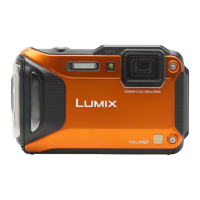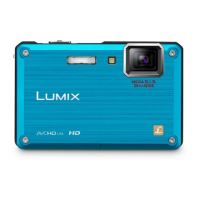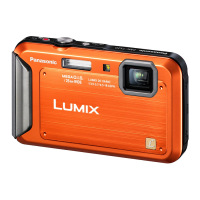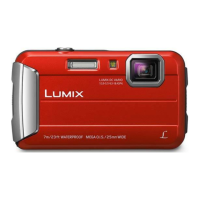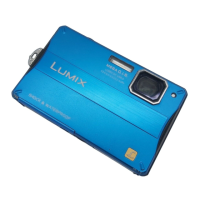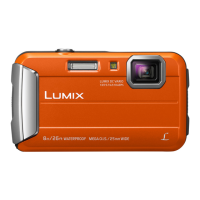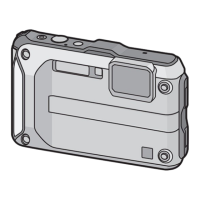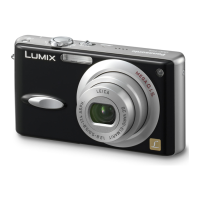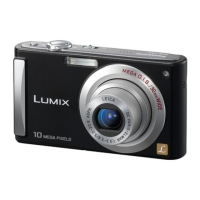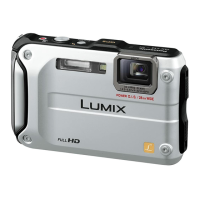
Do you have a question about the Panasonic Lumix DMC-FT3 and is the answer not in the manual?
| Camera type | Compact camera |
|---|---|
| Sensor type | CCD |
| Image stabilizer | Yes |
| Image sensor size | 1/2.33 \ |
| Image formats supported | JPG |
| Supported aspect ratios | 3:2, 4:3, 16:9 |
| Maximum image resolution | 4000 x 3000 pixels |
| Still image resolution(s) | 480 x 480, 640 x 360, 640 x 424, 640 x 480, 1280 x 720, 1536 x 1536, 1600 x 1200, 1920 x 1080, 1920 x 1920, 2048 x 1360, 2448 x 2448, 2560 x 1440, 2560 x 1712, 2560 x 1920, 2992 x 2992, 3264 x 1840, 3264 x 2176, 3264 x 2448, 4000 x 2240, 4000 x 2248, 4000 x 2672, 4000 x 3000 |
| Digital zoom | 4 x |
| Optical zoom | 4.6 x |
| Combined zoom | 18.4 x |
| Extra/Smart zoom | 6 x |
| Focal length range | 4.9 - 22.8 mm |
| Maximum aperture number | 5.9 |
| Minimum aperture number | 3.3 |
| Number of aspheric elements | 5 |
| Lens structure (elements/groups) | 10/8 |
| Maximum focal length (35mm film equiv) | 128 mm |
| Minimum focal length (35mm film equiv) | 28 mm |
| Focus adjustment | Auto |
| Auto focusing (AF) modes | Continuous Auto Focus |
| Macro focusing range (tele) | 0.3 m |
| ISO sensitivity | 100, 200, 400, 800, 1600, 3200, 6400, Auto |
| Light exposure control | Program AE |
| Light exposure correction | ± 2EV (1/3EV step) |
| Camera shutter type | Electronic |
| Camera shutter interval | 0.3 s |
| Fastest camera shutter speed | 1/1300 s |
| Slowest camera shutter speed | 8 s |
| Flash modes | Auto, Forced off, Forced on, Red-eye reduction, Slow synchronization |
| Flash range (tele) | 0.3 - 3.1 m |
| Flash range (wide) | 0.3 - 5.6 m |
| Power source type | Battery |
| Scene modes | Candlelight, Children, Close-up (macro), Fireworks, Night landscape, Night portrait, Party (indoor), Portrait, Self-portrait, Snow, Sports, Sunset, Landscape (scenery) |
| Photo effects | Black&White, Sepia, Skin tones, Vivid |
| White balance | Auto, Cloudy, Daylight, Incandescent, Shade |
| Camera playback | Movie, Single image, Slide show, Thumbnails |
| Self-timer delay | 2, 10 s |
| Camera file system | DCF 2.0, DPOF 1.1, Exif 2.3 |
| On Screen Display (OSD) languages | DEU, ENG, FRE, ITA, JPN |
| Video resolutions | 320 x 240, 640 x 480, 1920 x 1080 pixels |
| Motion JPEG frame rate | 30 fps |
| Video formats supported | AVCHD, M-JPEG, Quicktime |
| Maximum video resolution | 1920 x 1080 pixels |
| Analog signal format system | PAL |
| Internal memory | 19 MB |
| Compatible memory cards | SD, SDHC, SDXC |
| Field of view | 100 % |
| Display diagonal | 2.7 \ |
| Display resolution (numeric) | 230000 pixels |
| USB version | 2.0 |
| Product color | Orange |
| Waterproof up to | 12 m |
| Freezeproof up to | -10 °C |
| Battery voltage | 3.6 V |
| Battery capacity | 940 mAh |
| Battery life (CIPA standard) | 310 shots |
| Cables included | AC, AV, USB |
| Bundled software | PHOTOfunSTUDIO 6.1 QuickTime Adobe Reader Super LoiLoScope |
| Depth | 26.5 mm |
|---|---|
| Width | 103.5 mm |
| Height | 64 mm |
| Weight | 175 g |
| Weight (including battery) | 197 g |
Instructions for handling, waterproof/dustproof, and anti-shock performance.
Names of camera parts, attaching strap, and battery charging.
Handling memory cards, built-in memory, and setting date/time.
Guide to choosing different shooting modes like Normal and Intelligent Auto.
Tips for good pictures, focusing, and preventing camera shake.
Instructions for capturing and viewing video footage.
Steps to remove images and navigate camera menus.
Using the zoom function and the built-in flash.
Close-up, self-timer, exposure compensation, and auto bracket.
Optimizing shooting for sports, snow, beach, and underwater scenes.
Using specific modes like Portrait, Night, Food, and 3D Photo.
Utilizing face recognition and recording location data.
Using compass, altimeter, and barometer for environmental information.
Setting vacation dates, locations, and world times.
Settings for aspect ratio, picture size, quality, sensitivity, and white balance.
AF modes, exposure, motion picture settings, and text input.
Creating stills from motion, slide shows, filtering, and calendar playback.
Configuring uploads, editing titles, cropping, and setting favorites.
Setting print options, protecting pictures, and copying files.
Viewing pictures on a TV via AV cable or HDMI and playing back 3D images.
Connecting to a PC for transferring and printing pictures.
Saving 3D pictures and uploading images to sharing sites.
Understanding screen elements and important usage warnings.
Cleaning, battery, charger, and 3D viewing precautions.
Handling memory cards and managing personal information.
Guidance on resolving common camera issues and error messages.
Addressing GPS, picture quality, playback, and connection problems.

